Learn how to make a potato flake sourdough starter. Made with sugar, dehydrated potatoes, and yeast, you can make delicious sandwich bread with a much sweeter taste than its typical sourdough counterpart.
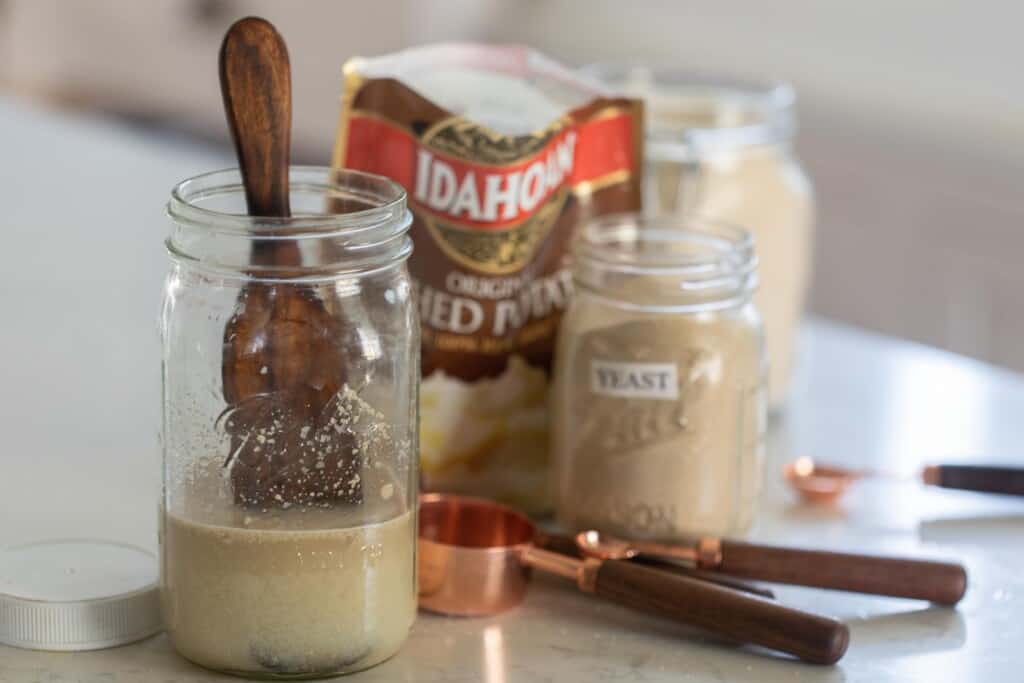
Table of Contents
- What is a potato flake sourdough starter?
- Why you’ll want a potato flake sourdough starter
- Tips for a sourdough bread starter with potato flakes
- FAQ
- Potato Flake Starter Ingredients
- How to make a potato flake sourdough starter
- How to maintain a potato flake sourdough starter
- Step-by-step instructions for maintaining your starter
- How to use your potato flake sourdough starter to make bread
- Directions:
- Check out more sourdough resources and recipes!
- Potato Flake Sourdough Starter Recipe
You know how much I love homemade sourdough bread. Sometimes, though, I do crave a sweeter bread with a little less of that signature sourdough tang and sourness.
I rarely make yeast breads. So, instead, I decided to make a potato flake starter recipe! This new starter is one of the traditional sourdough starter replacement methods.
Instead of a traditional San Francisco-style starter using flour and water, the potato flake version uses yeast, sugar, water, and dehydrated potatoes. That’s right — dehydrated potatoes!
This new starter is different from what some know as the Amish friendship bread starter (also known as southern style), although both typically use yeast to get started and include sugar.
The potato flake version gives bread a sweet taste. That’s why I love to use it on breads like sandwich bread, rolls, or even sweeter baked goods such as cinnamon rolls.
You can even use your potato flake starter discard in any of my discard recipes! This is perfect for anyone that isn’t sold on the sour in sourdough.
Today, I am going to share with you how I made my potato flake starter and how to properly care for and maintain it.
Plus, I’ve included a beginner bread recipe for you to try once your starter is ready to use! It is a take on my sourdough sandwich bread recipe with a few ingredient swaps and using potato flake starter instead of my regular starter.
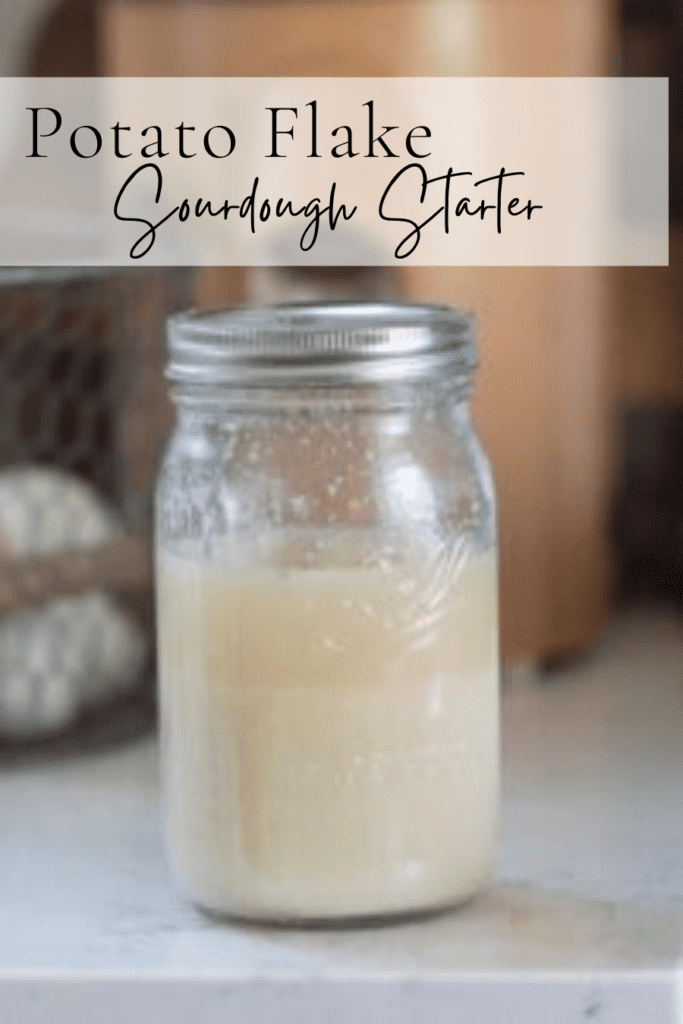
What is a potato flake sourdough starter?
A potato flake sourdough starter is made with dehydrated potato flakes, yeast, sugar, and water. When used in baking, it is what causes your bread to rise. It will give your baked goods a much sweeter taste than a traditional sourdough loaf. This starter is also gluten free and dairy free.
Note that not all yeast is gluten free. If you are strictly gluten free, you can reference this page to see what yeasts will work for you. A commercial yeast packet – active dry yeast or instant yeast – is typically considered gluten free.
This post contains affiliate links, which means I make a small commission at no extra cost to you. See my full disclosure here.
Why you’ll want a potato flake sourdough starter
A potato flake sourdough starter is fairly easy to maintain. Plus, this type of starter will result in a sweeter and less sour taste in your final product. I like it best in sandwich bread recipes or dinner rolls.
I’ve included a sourdough recipe below that is similar to my regular sandwich bread, but uses a potato flake starter instead!
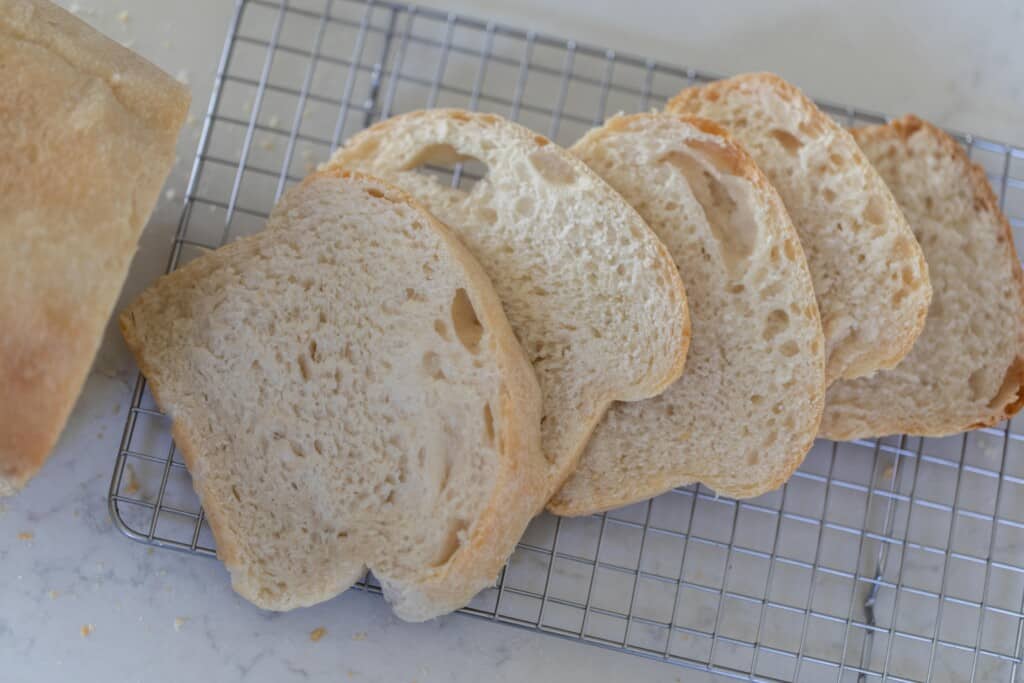
Tips for a sourdough bread starter with potato flakes
- Unlike your typical sourdough starter made with just flour and water, a potato flake starter will be a lot thinner. Of course, this will affect how much water you add to the recipe.
- If your potato flakes settle to the bottom – that is okay! It likely won’t stay incorporated, and that is normal. Simply give it a quick stir before use.
- Store your potato flake starter in the fridge. I try to feed it once a week to keep it thriving.
- If you do not want to make bread, you can discard one cup of the starter before feeding and use it in a sourdough discard recipe. My discard recipes call for traditional sourdough starter, but you can also use a potato flake starter instead. Check out some of those recipes here!
FAQ
A sourdough starter replaces the yeast in bread. It is the starter that allows bread to rise. Otherwise, your loaf would turn out flat and dense.
A traditional sourdough starter typically only uses flour and water to both create it and maintain it. A potato flake starter requires sugar, yeast, water, and potato flakes to get it started. To maintain it, you skip the yeast, but will still have to feed it sugar, water, and potato flakes! It tends to give breads a much sweeter taste than regular sourdough bread. If you’d like to learn how to make a traditional sourdough starter, click here!
It is sweeter and less sour.
Indefinitely, as long as you continue to maintain/feed it!
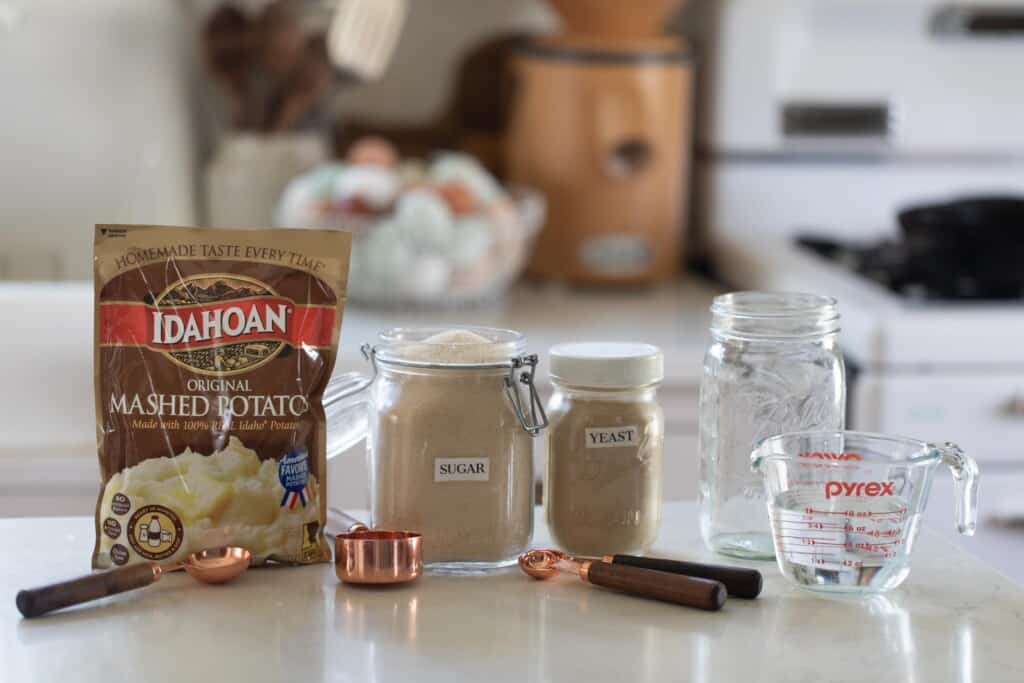
Potato Flake Starter Ingredients
This recipe will use potato flakes, sugar and commercial yeast to get it going. After it gets established, the wild yeasts will take over, and you will only have to feed it potato flakes, sugar and water.
1 cup warm water
1/4 cup sugar
1 package dry yeast (2 1/4 teaspoons)
3 tablespoons instant potato flakes
Tools to help you get started
Glass container/jar or large bowl
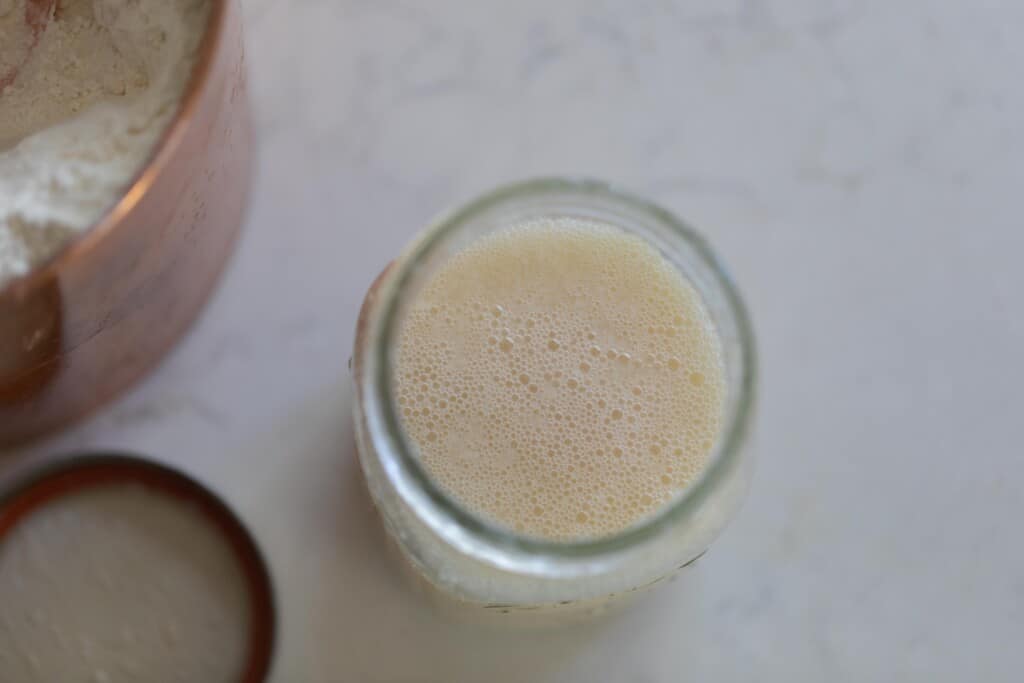
How to make a potato flake sourdough starter
- Start with a clean glass container or a large bowl.
- Add in the warm water, potato flakes, sugar and yeast.
- Stir everything together and scrape down the sides.
- Cover with something that is slightly breathable. You can use a tea towel or coffee filter with a rubber band. I like to use a flip top canister with the rubber gasket taken out or a glass jar with a glass lid. Both of these are not airtight, so the gasses (which are a natural bi product of fermentation) can escape.
- Leave it at room temperature for 4 days, stirring daily.
- On the 5th day, feed the starter with 1 cup warm water, 1/4 cup sugar and 3 tablespoons of instant potato flakes. Stir it well and allow it to sit at room temperature for 8 hours.
- Remove 1 cup of the starter to make your bread. Place the remaining starter in the refrigerator. (see instructions below to maintain for future use.)
How to maintain a potato flake sourdough starter
You maintain a potato flake sourdough starter a lot like you maintain a regular one, except you use different ingredients!
We used a package of commercial yeast to jumpstart this process originally, but you will not need it to maintain your starter.
Maintenance Ingredients
1 cup warm water
1/4 cup of sugar
3 tablespoons instant potato flakes
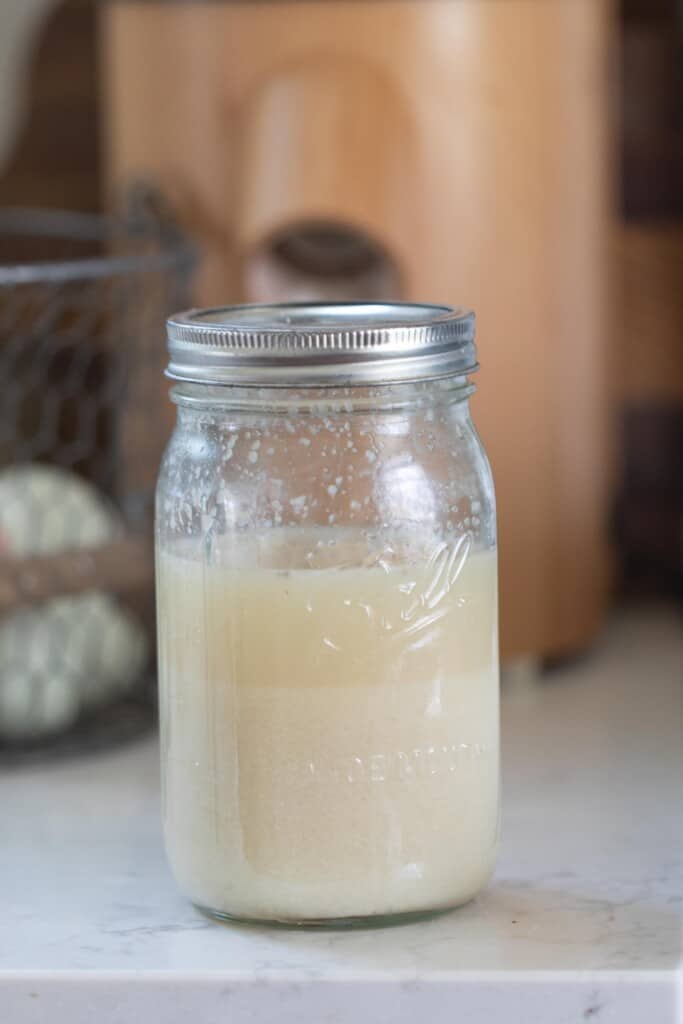
Step-by-step instructions for maintaining your starter
Remove your starter from the refrigerator, and feed it with 1 cup of warm water, 1/4 cup sugar and 3 tablespoons of instant potato flakes. Allow it to sit at room temperature for 6 hours, or until it looks bubbly and active.
Remove 1 cup of the starter to make potato flake sourdough starter bread. Put it back in the refrigerator until you want to repeat this process and make another loaf of bread.
Storing your potato flake starter in the refrigerator
Just like with a regular sourdough starter, you can store it in the refrigerator for several weeks in between uses, but it stays most active if you feed it regularly. Aim for once a week.
If you do not want to make bread, you can discard one cup of the starter before feeding and use it in a sourdough discard recipe. My discard recipes call for traditional sourdough starter, but you can also use a potato flake starter instead. Check out some sourdough discard recipes here.
How to use your potato flake sourdough starter to make bread
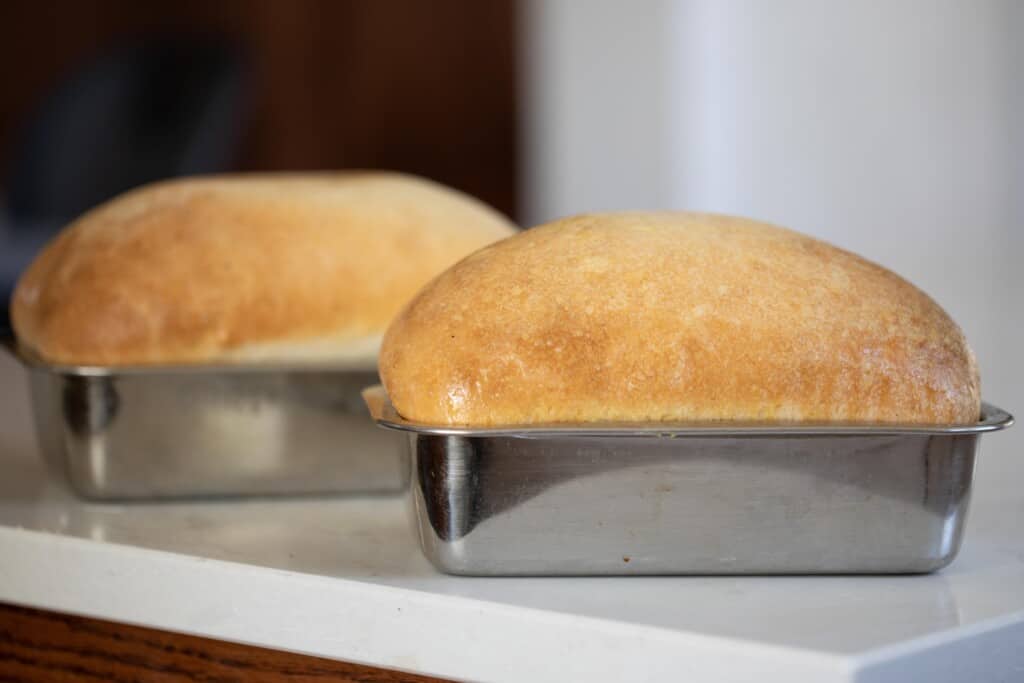
Ingredients
1/2 cup butter (softened) or coconut oil (113 g)– Use coconut oil if you are making this dairy-free or simply like more of a coconut taste.
1/2 cup sugar (96 grams)
1 tbs salt (17 grams) – I use a tablespoon salt, and prefer to use sea salt if possible!
1 cup potato flake sourdough starter (275 g), active and bubbly, active and bubbly
2 1/4 cups water (531 g)
8 cups all purpose flour (1200 g)
Tools you may need
Measuring cups and spoons (or a kitchen scale)
9.5 in by 5 in Loaf pans
Directions:
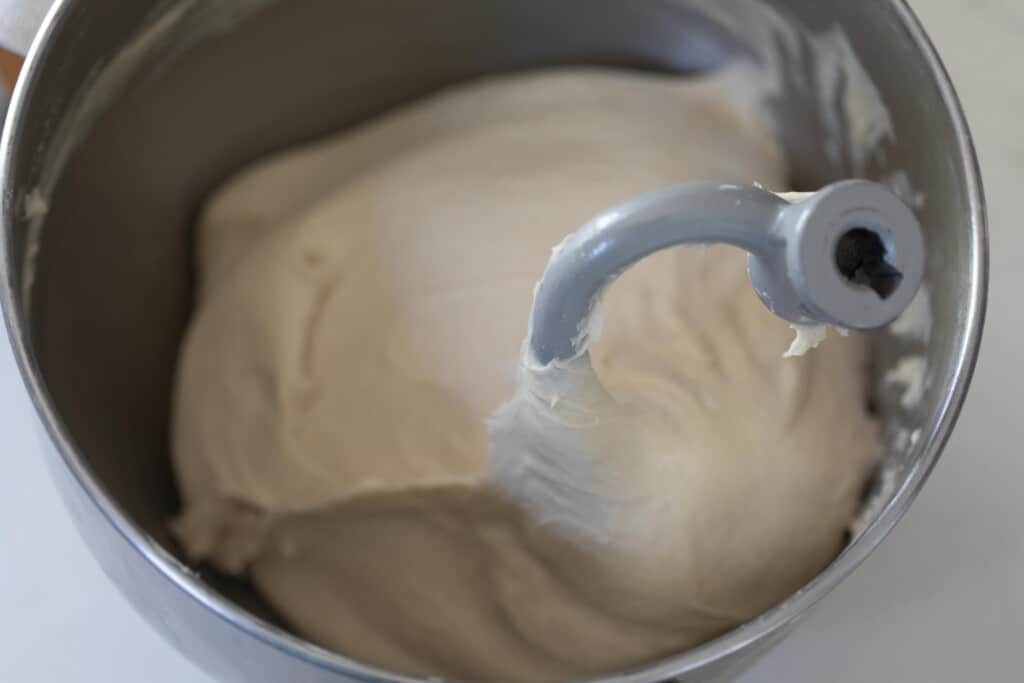
Mix ingredients
Add all of the ingredients to a stand mixer. I recommend adding the flour last. This way you can add more or less as needed, pending your starters hydration level.
Knead the dough
Turn on your stand mixer and knead the dough until it is stretchy and smooth. It will take about 10 minutes. When it is ready, it will pull away from the sides of the bowl and be elastic and smooth.
Make sure it passes the windowpane test! Grab a small ball of the dough and stretch it into a square. It should stretch thin enough to see through without breaking.
Bulk Rise
In a warm place, allow your dough ball to bulk rise for 10-12 hours. You can go longer if you want the benefit of the fermentation. However, don’t overproof! It will turn your dough into a sloppy mess.
Shape and rise
Prepare two loaf pans by either greasing them or adding pieces of parchment paper.
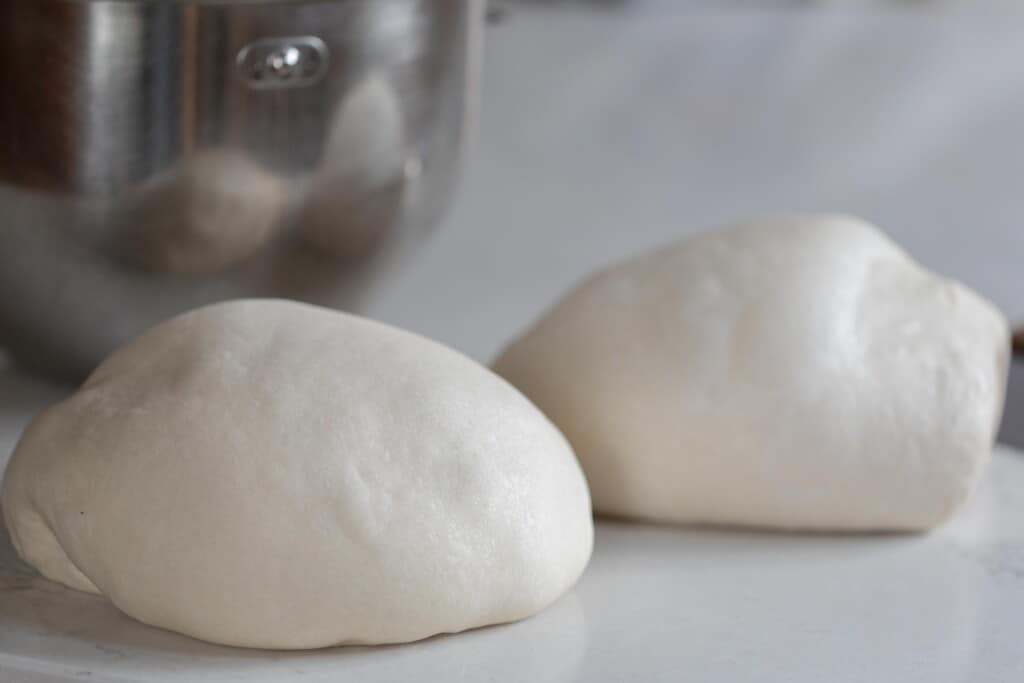
Divide dough into two equal parts.
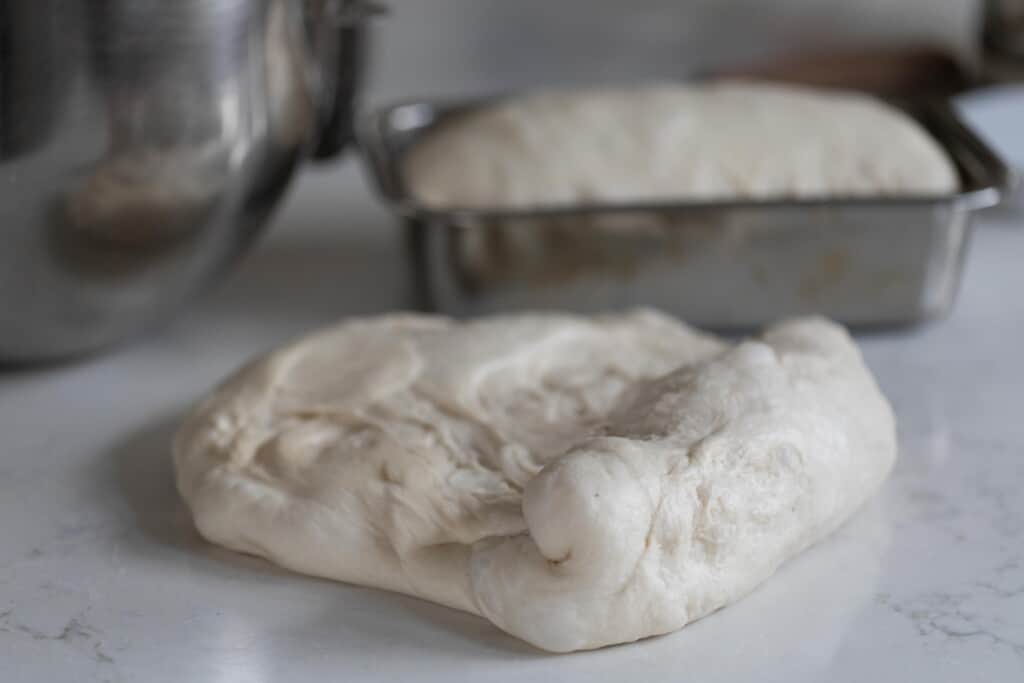
To shape your dough, roll it out flat into a rectangle and then roll it up.
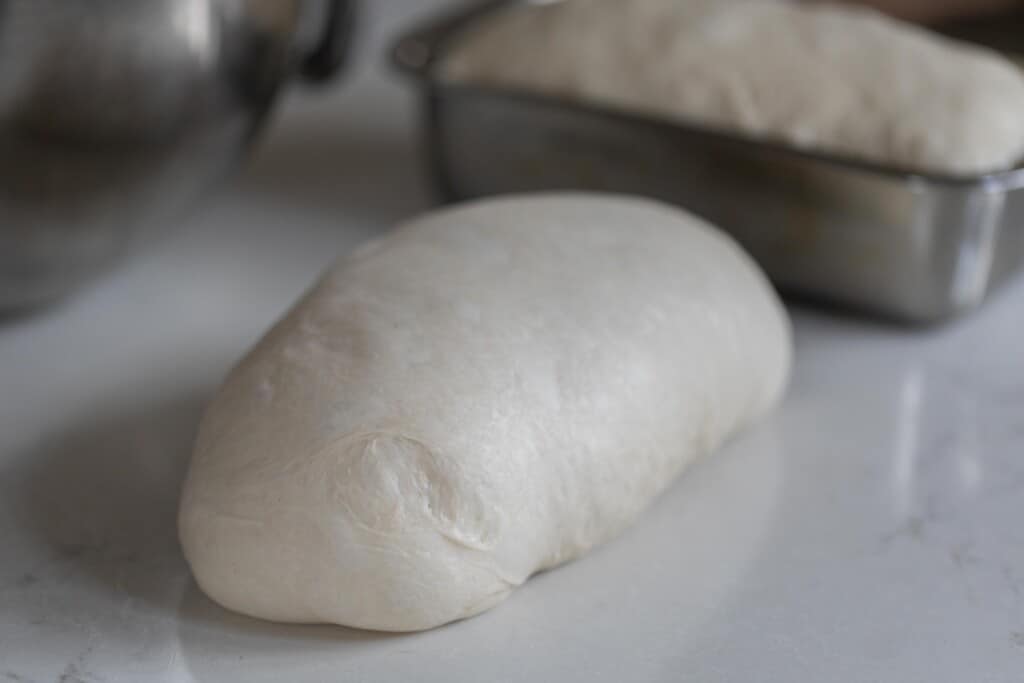
Allow to rise again for 2- 4 hours at room temperature or until doubled. The amount of time all depends on the temperature of your home.
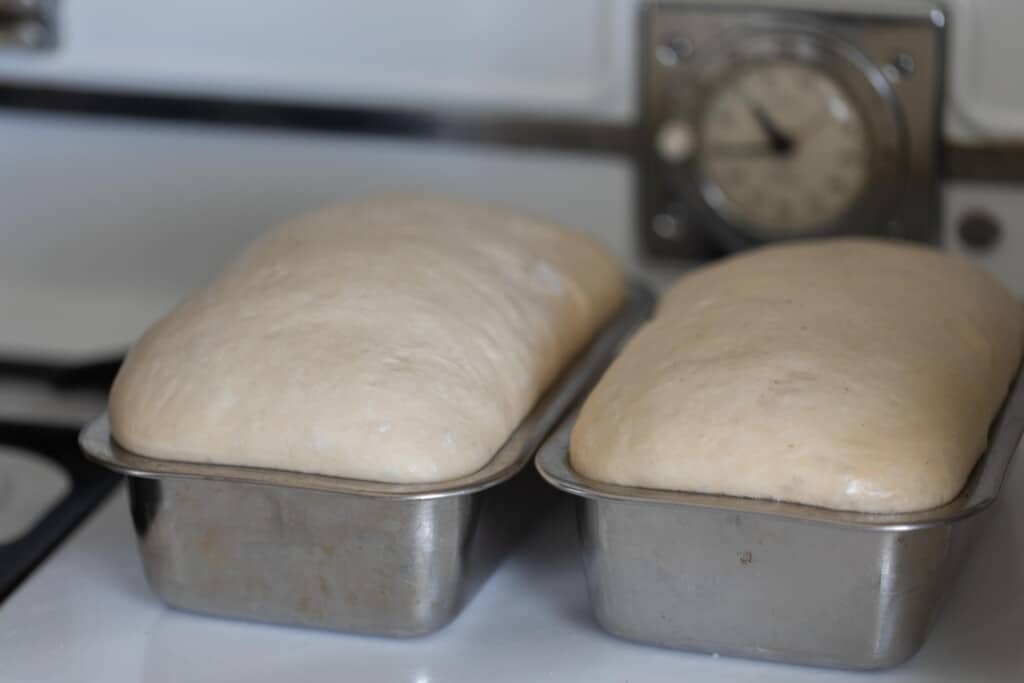
Bake
Optional: Add an egg wash on top of the loaves before baking. This provides more browning.
Bake at 375 for 45 minutes, or until golden on top.
Allow to cool completely before slicing.
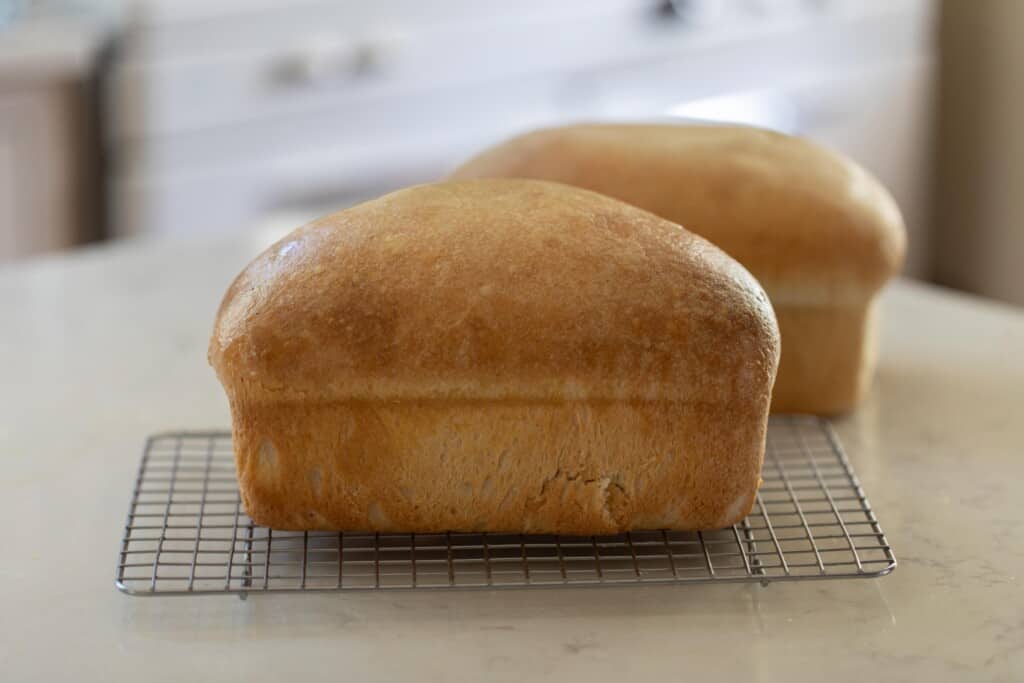
Check out more sourdough resources and recipes!
- Learn how to make a traditional sourdough starter
- How to maintain a traditional sourdough starter
- Gluten Free Sourdough Starter
- Sourdough Cinnamon Rolls
- Sourdough Dinner Rolls
If you try this recipe and love it, I would love it if you gave it 5 stars! Thank you! Tag me on Instagram @farmhouseonboone.
Potato Flake Sourdough Starter
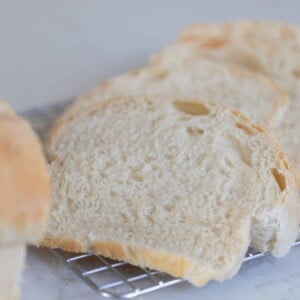
Ingredients
- 1 cup warm water
- 1/4 cup sugar
- 1 package dry yeast, 2 1/4 teaspoons
- 3 tablespoons instant potato flakes
Instructions
- Start with a clean glass container or a large bowl.
- Add in the warm water, potato flakes, sugar and yeast.
- Stir everything together and scrape down the sides.
- Cover with something that is slightly breathable. You can use a tea towel or coffee filter with a rubber band. I like to use a flip top canister with the rubber gasket taken out or a glass jar with a glass lid.
- Both of these are not airtight, so the gasses (which are a natural bi product of fermentation) can escape.
- Leave it at room temperature for 4 days, stirring daily.
- On the 5th day, feed the starter with 1 cup warm water, 1/4 cup sugar and 3 tablespoons of instant potato flakes. Stir it well and allow it to sit at room temperature for 8 hours.
- Remove 1 cup of the starter to make your bread. Place the remaining starter in the refrigerator.
Maintaining The Starter
- Remove your starter from the refrigerator, and feed it with 1 cup of warm water, 1/4 cup sugar and 3 tablespoons of instant potato flakes.
- Allow it to sit at room temperature for 6 hours, or until it looks bubbly and active.
- Once bubbly, it can be used in bread recipes.
- Keep stored in the fridge between uses. Feed every 3-5 days
Notes
Nutrition
Nutrition information is automatically calculated, so should only be used as an approximation.










Can you. tell me the carbohydrate count, please? Diabetics will certainly appreciate this info.
Ok…I get that this is a starter…but where are the instructions to turn it into bread…. How much gluten free flour do you add.. how long do you bake it and at what temp. ?? Thanks ..would lo]ve to try this but don’t feel it finished instructing us as how it becomes a loaf of bread ? Thanks…
The bread recipe is in the blog post. Unfortunately, you are not supposed to put two recipe cards in one post of else I would have. It is not a gluten free bread though.
I’d like to know if anyone has done the bread recipe with gf flour. What brand of flour and did it work?
If you are not making Bread, and you need to feed your starter, you said to remove one cup of discard. However, can the starter go back in the fridge right after? Or does it need to sit out at room temperature?
If you are not planning to bake with it, place it back in the fridge. This slows down the fermentation. Otherwise you will need to feed it daily.
Can this be used as a type of gluten free starter using gf flours? My granddaughter recently she found out she was celiac
Following for the answer to this!
I’m really not sure. I would think so, but have never tried it.
This is just the bread I want to add to my ‘plate’, thank you for this.
Wondering though, would home grown potatoes, dried and ground, work for this?
I love this! Thanks for sharing! Please share any recipes you come up with for this starter! I’ve had this starter for several years – I got it from my grandma, who got it from my great grandma. I always felt like I was “cheating” because it’s so different (and much easier) than typical sourdough. I only have 3-4 recipes for this starter, but I do recommend it for cinnamon rolls!!! They are amazing!
I would love any recipes you have using this kind of starter! My mom passed it down to me; she’s had it for years but I don’t think has made anything besides loaves with it. I want to venture out with it!
I make cinammon rolls with mine. The best!!
How do you know the starter is good and ready to use? If baking, do you remove it from the fridge to bring to room temp before using it in a bread recipe?
It should be really bubbly and active about 4-12 hours after feeding. If it is stored in the fridge, you will want to take it out, feed it, and then let it become active (4-12 hours and about doubling in size) before using it in a bread recipe.
Thank you
Wow !! How did you get this recepee ? Could it be coming from the epoch of depression ??
When flour was soo expensive?? When you say potato flakes meaning that those flakes are the same when you make mash potatoes with dehydrated potato flakes??
Will try one day .. thank you for sharing too!!!
I had to laugh if I didn’t it wouldn’t be naturel to
Me !!!
I bet you never made a serie like this!!
Here’s the « I love Lucy show!!! »
Just today I made a blessing mess in my kitchen!!! I have a bread machine and I live in France and have some bread recepees but in gram.. so I did some maths between cups and grams..now I got it but since I was tired!! I put in my machine two cups of sourdough instead of one!! Then I realized with horror after « I was so mad « .. I put water in my rye container instead in my sourdough container that was right next to the sourdough container..to feed it since I drained it with two cups!!! Afterwards I put the💥💥 water and remaining rye flour that did get wet into my sourdough container, not wanting it to go on waste… but I don’t know what was the amount of rye flour or water!!!
Now I am trying to dry my rye flour remaining that didn’t get wet !!! AND SITTING AT THE KITCHEN TABLE TO RELAX A BIT.. I TURNED MY HEAD hearing the HEATING OF THE OVEN .. and realized that I forgot to put the butter in my dough!!!
SO I STOPPED THE MACHINE AND ADDED THE BUTTER IN THE BATTER.. started the machine over again.. while it was turning … again I heard in the machine clic clic !!!💥💥
I was going to explode right there !! BUT THE MACHINE STOPPED TURNING BECAUSE IT WAS at THE END OF IT’S program !!
Now I’m waiting for the result!! I told my husband that he might need to go to the dentist if the bread is too hard!!
If so I will just let it dry completely and put it in a blender to make bread crumbs!!
And tomorrow will start again another bread !!
🙃🤪
Lisa, do you think this would work with whole wheat flour? I made this bread for years when my children were young. Delicious! But now I mill my grains, and I wonder how it would work with freshly milled flour.
Thank you! I made this bread in college in the 90s & haven’t been able to find it since! I loved this bread.
Also, started my SD starter in Oct22 based on your instructions. My husband named it ‘Dough Boy’ because Oh Boy, dough is all over the counter!!! LOL. Today, 4/26/23, I was able to bless a 12 year old, homeschooler with a starter so she could start her SD journey for her homesteading family in a neighboring count. THANK YOU , LISA!! You have been a blessing to me and MANY others without your knowing it. Felt good to
pass on some of ‘Dough Boy’ to bless someone else❣️
I love that so much! I’m so glad you enjoyed this recipe!